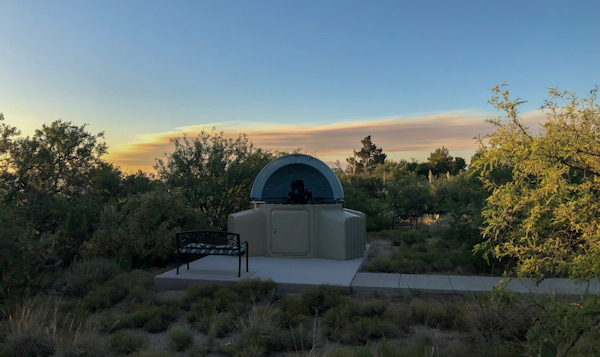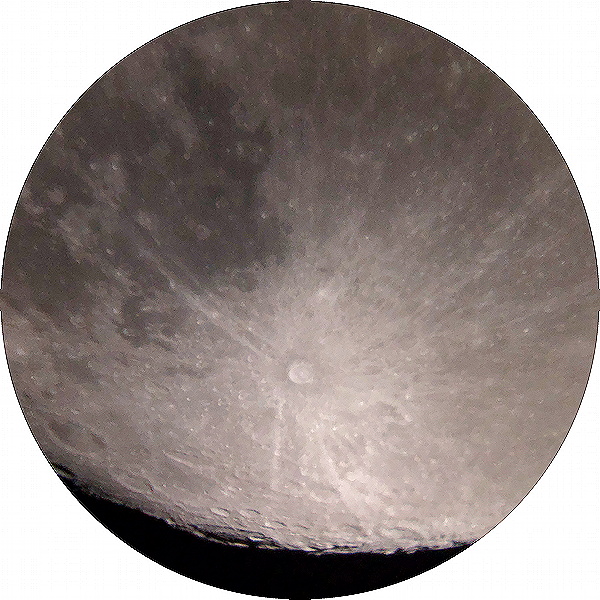iPhone 8 Plus imaging: Moon, Mercury, Jupiter
Posted: 16 June 2019
As forecast, Thursday, 13 June 2019, was cloudy. Friday, 14 June, dawned clear with a clear sky forecast for the night, but strong winds began mid-morning and continued into the night.
It's a bird. It's a plane. It's Supersquirrel!

Photo from our Trailcampro wildlife camera captured 14 June 2019
Saturday, 15 June, was clear and calmer.
|
Open: Saturday, 15 June 2019, 1901 MST Temperature: 87°F |
Session: 1362 Conditions: Clear |
Equipment Used:
12" f/8 LX600 w/StarLock
2" 24mm UWA eyepiece
1.25" 15mm eyepiece
2" 30mm eyepiece
2" 2X Powermate
Camera:
D850 DSLR
iPhone 8 Plus
There was a lot of smoke from the Woodbury Fire (about an hour north of Oracle) visible along the northern horizon:

The fire had burned 34,000 acres by Saturday night.
I relaxed on the observatory patio bench while waiting for the Moon to rise. 1923 MST: it finally rose over the hill to the east (D850 DSLR, f/11, 1/200sec, ISO 200, FL 300mm):

1936 MST: sunset (D850 DSLR, f/22, 1/500sec, ISO 400, FL 300mm, cropped):

1940 MST: LX600 ON, StarLock OFF, High Precision OFF.
Viewed the planet Mercury, 102X and 163X. Mounted the iPhone 8 Plus on the 12" telescope using the Phone Skope adapter and remote for this afocal 163X image of Mercury using NightCap Camera (ISO 22, 1/200sec):

1957 MST: slewed to the Moon, which was still behind a tree. Relaxed on the bench for awhile.
2012 MST: did some Moon viewing, 102X. A slight terminator was visible.
Mounted the iPhone using the Phone Skope adapter for this afocal 81X image of the Moon with NightCap Camera (ISO 22, 1/4400sec):

2023 MST: I was buzzed by a Kissing Bug, which landed by my logbook. It was terminated.
Did some lunar observing, 163X.
2033 MST: Kissing Bug #2 terminated.
Using the Phone Skope adapter and remote, took this afocal 163X image of the crater Tycho with NightCap Camera (ISO 22, 1/3200sec):

2042 MST: Kissing Bugs #3 and #4 terminated.
2043 MST: viewed Jupiter, low in the southeast, 163X. The four Galilean Moons were visible. Both the North Equatorial Belt and the South Equatorial Belt appeared to be very thin.
Viewed Jupiter using the Vortex 12x50 binoculars. The four moons were easily seen. Then viewed the Moon using the 12x50 binoculars. It was pretty and bright.
2048 MST: I noticed that the smoke from the Woodbury Fire was now about 30° high in the northern and eastern sky. I decided I would have to image Jupiter sooner than planned as the smoke was moving south.
2100 MST: mounted the iPhone on the telescope for this afocal 163X image showing Jupiter and the four moons. The image is a merge of two NightCap Camera images (ISO 200, 1/5sec for the moons and ISO 22, 1/60sec for the planet):

2106 MST: I could now smell the smoke from the Woodbury Fire.
Added the 2X Powermate for this afocal 325X image of Jupiter and its moon Ganymede taken with NightCap Camera (ISO 22, 1/30sec):

2115 MST: ended imaging as the smoke was now near Jupiter.
2120 MST: last look at Jupiter, 102X.
2121 MST: LX600 OFF.
2128 MST: Kissing Bugs #5 and #6 terminated.
|
Close: Saturday, 15 June 2019, 2133 MST Temperature: 75°F |
Session Length: 2h 27m Conditions: Clear, smokey |
Comments are welcome using Email. Twitter users can use the button below to tweet this report to their followers. Thanks.
Cassiopeia Observatory Home Page
Copyright ©2019 Michael L. Weasner / mweasner@me.com
URL = http://www.weasner.com/co/Reports/2019/06/16/index.html
